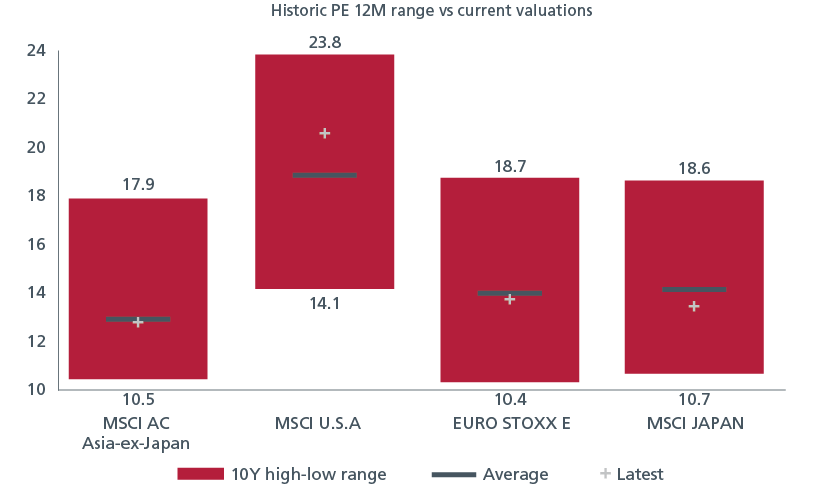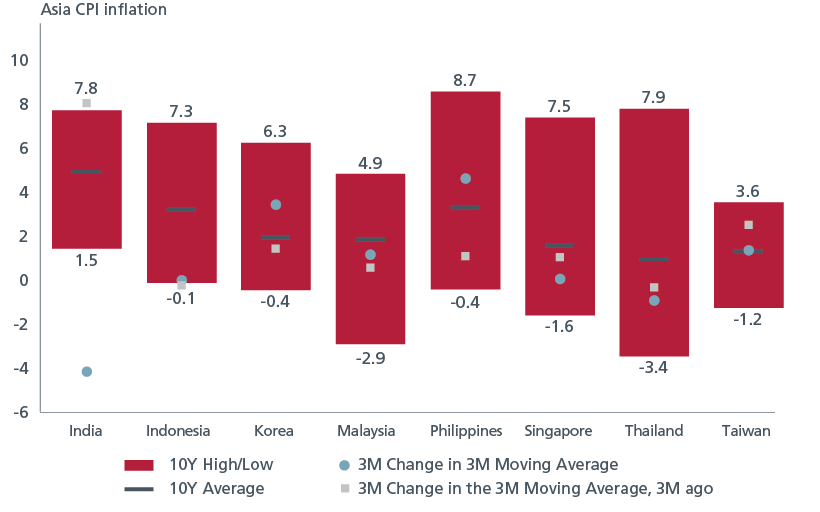Summary
US growth is likely to slow sharply, and recession risk has risen meaningfully. A slower rate of earnings in the US will also no longer justify US equities’ premium valuation. In contrast, Asian markets are trading just under historic average valuations and so relatively defensive.
What’s top of investors’ minds
US equity underperformance to resume as the year progresses
Our expectation for US equities to derate at least 10%, and more likely more than 15% this year forms the basis of our portfolio strategy. The S&P 500 12m forward P/E ratio is 19.8x at the time of writing, a 9% premium to its 35- year average based on Bloomberg data. A premium valuation made sense last year when the US economy was growing above its trend rate and much faster than other developed economies. However, we estimate that the Trump Administration policy – much less immigration, cuts to Federal spending and employment, and a roughly 20 percentage point increase in the US’ effective tariff rate – will cut US growth to sub-1% this year with a negative effect on corporate earnings. This sharp fall in the US growth trajectory and slower rate of earnings growth no longer justify US equities’ premium valuations. We expect the S&P 500 to derate to at least its long-term (35-year) average and more likely to below this.
Premium US valuation no longer justified by US growth

In contrast, Asian markets are trading just under historic average valuations and so relatively defensive. Our focus is on a) countries that can deliver policy stimulus to offset some of the tariff shock, b) markets where company specific factors are pushing up return on equity, and c) low volatility equity strategies to manage risk.
India stands out to us as being well positioned to weather the tariff shock this year. India’s exports of goods to the US are the second lowest in Asia at only 2.2% of GDP. Importantly, India’s government had begun proposing tariff rate cuts to the US even before Trump announced “reciprocal” tariffs on April 2, increasing the likelihood of a trade deal with the US. India may also benefit from global companies relocating production from China to reduce tariff exposure. Equally important, the sharp fall in Indian inflation to less than 4% yoy gives the Reserve Bank of India room to cut interest rates another 50bps and possibly 75bps in an effort to reflate the economy and asset prices.
We acknowledge that tariffs reduce Japan’s growth potential this year, particularly auto tariffs, and we now expect GDP growth of only 0.6% - 0.8%, down from 1.1% previously. However, rising wage growth should allow a bounce in consumption growth that works to offset some of the hit from tariffs. We also see continued improvement in corporate governance that works to raise return on equity, distribute excessive cash holdings, and unlock value via mergers and acquisitions.
China is admittedly tricky for investors because of the large headwind to growth that tariffs imply. The increase in the US tariff rate on China to 125% represents a roughly 3% of GDP drag on growth if sustained for the full year. However, China’s government announced 2% of GDP worth of fiscal stimulus at the NPC in March and we expect it to increase this significantly to try to keep GDP growth above 4%. This implies large support for consumption, accelerated purchases of idle property, and increased investment in industry, particularly in technology.
Nonetheless, with US growth likely to slow sharply and recession risk having risen meaningfully, we expect government bond yields to grind lower over the course of the year. Most central banks, including the Federal Reserve ultimately, are likely to cut policy rates significantly, pulling down yield levels.
Low Asian inflation leaves room for rate cuts and lower yields

The information and views expressed herein do not constitute an offer or solicitation to deal in shares of any securities or financial instruments and it is not intended for distribution or use by anyone or entity located in any jurisdiction where such distribution would be unlawful or prohibited. The information does not constitute investment advice or an offer to provide investment advisory or investment management service or the solicitation of an offer to provide investment advisory or investment management services in any jurisdiction in which an offer or solicitation would be unlawful under the securities laws of that jurisdiction.
Past performance and the predictions, projections, or forecasts on the economy, securities markets or the economic trends of the markets are not necessarily indicative of the future or likely performance of Eastspring Investments or any of the strategies managed by Eastspring Investments. An investment is subject to investment risks, including the possible loss of the principal amount invested. Where an investment is denominated in another currency, exchange rates may have an adverse effect on the value price or income of that investment. Furthermore, exposure to a single country market, specific portfolio composition or management techniques may potentially increase volatility.
Any securities mentioned are included for illustration purposes only. It should not be considered a recommendation to purchase or sell such securities. There is no assurance that any security discussed herein will remain in the portfolio at the time you receive this document or that security sold has not been repurchased.
The information provided herein is believed to be reliable at time of publication and based on matters as they exist as of the date of preparation of this report and not as of any future date. Eastspring Investments undertakes no (and disclaims any) obligation to update, modify or amend this document or to otherwise notify you in the event that any matter stated in the materials, or any opinion, projection, forecast or estimate set forth in the document, changes or subsequently becomes inaccurate. Eastspring Investments personnel may develop views and opinions that are not stated in the materials or that are contrary to the views and opinions stated in the materials at any time and from time to time as the result of a negative factor that comes to its attention in respect to an investment or for any other reason or for no reason. Eastspring Investments shall not and shall have no duty to notify you of any such views and opinions. This document is solely for information and does not have any regard to the specific investment objectives, financial or tax situation and the particular needs of any specific person who may receive this document.
Eastspring Investments Inc. (Eastspring US) primary activity is to provide certain marketing, sales servicing, and client support in the US on behalf of Eastspring Investment (Singapore) Limited (“Eastspring Singapore”). Eastspring Singapore is an affiliated investment management entity that is domiciled and registered under, among other regulatory bodies, the Monetary Authority of Singapore (MAS). Eastspring Singapore and Eastspring US are both registered with the US Securities and Exchange Commission as a registered investment adviser. Registration as an adviser does not imply a level of skill or training. Eastspring US seeks to identify and introduce to Eastspring Singapore potential institutional client prospects. Such prospects, once introduced, would contract directly with Eastspring Singapore for any investment management or advisory services. Additional information about Eastspring Singapore and Eastspring US is also is available on the SEC’s website at www.adviserinfo.sec. gov.
Certain information contained herein constitutes "forward-looking statements", which can be identified by the use of forward-looking terminology such as "may", "will", "should", "expect", "anticipate", "project", "estimate", "intend", "continue" or "believe" or the negatives thereof, other variations thereof or comparable terminology. Such information is based on expectations, estimates and projections (and assumptions underlying such information) and cannot be relied upon as a guarantee of future performance. Due to various risks and uncertainties, actual events or results, or the actual performance of any fund may differ materially from those reflected or contemplated in such forward-looking statements.
Eastspring Investments companies (excluding JV companies) are ultimately wholly-owned / indirect subsidiaries / associate of Prudential plc of the United Kingdom. Eastspring Investments companies (including JV’s) and Prudential plc are not affiliated in any manner with Prudential Financial, Inc., a company whose principal place of business is in the United States of America.





